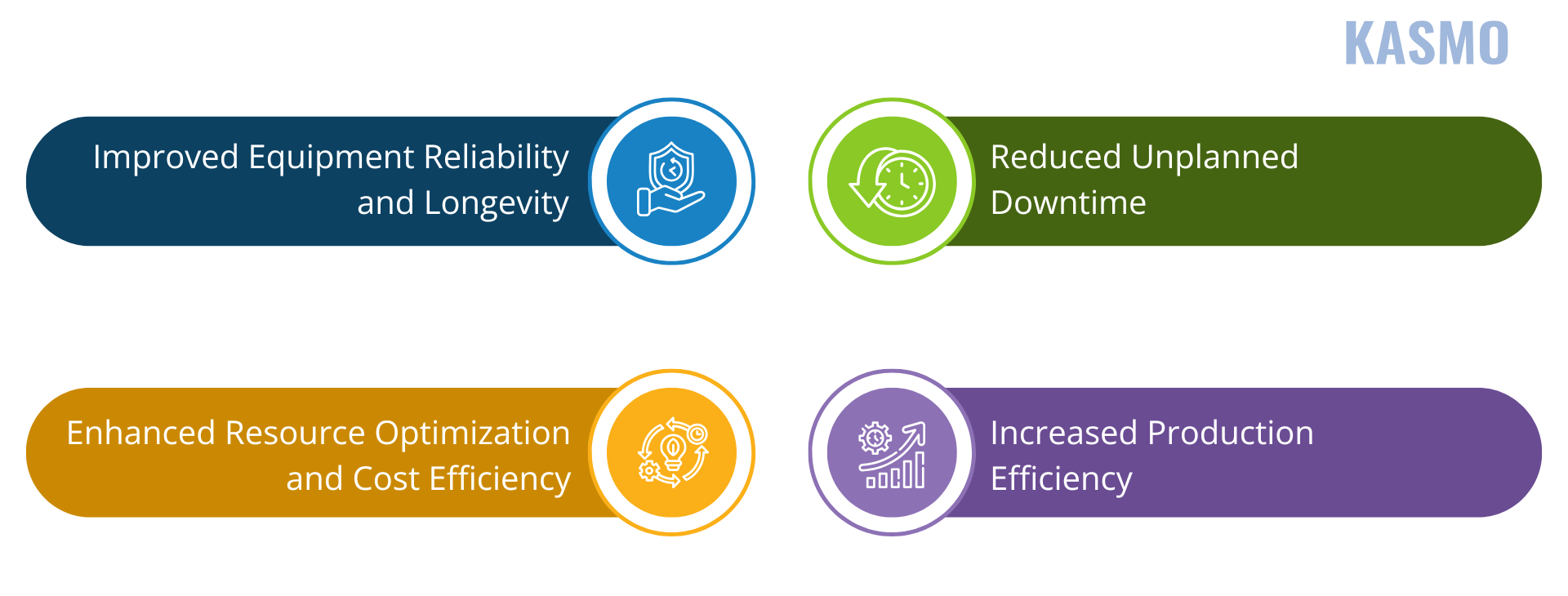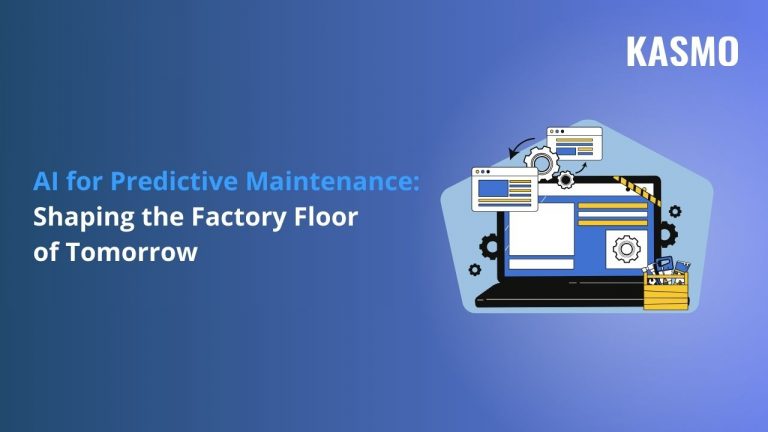Introduction
The manufacturing industry is undergoing an exciting technological revolution. Among the many innovations that have transformed their operations, predictive maintenance has created a significant impact. By leveraging machine learning models and AI for predictive maintenance, manufacturers can gain unprecedented insights into their operations, optimize productivity, reduce downtime, and achieve better cost efficiency.
With predictive maintenance manufacturers can eliminate their traditional maintenance schedules and take more data-driven decision-making. This helps them to ensure that their equipment operates seamlessly while minimizing disruptions.
In this blog, we will explore how leveraging AI for predictive maintenance can transform the manufacturing industry. We’ll examine how Snowflake helps manufacturers gain a comprehensive overview of their processes and discuss how Kasmo’s Snowflake accelerators for manufacturers can revolutionize your business operations.
What Is Predictive Maintenance in Manufacturing?
Predictive maintenance in manufacturing is an advanced approach that aims to predict when an equipment will fail or require maintenance, allowing manufacturers to perform necessary repairs before a breakdown occurs. Unlike traditional maintenance methods, where machinery is either serviced on a scheduled basis (preventive maintenance) or after it breaks down (reactive maintenance), using AI in predictive maintenance will help you continuously monitor and assess equipment health. This proactive strategy ensures that your equipment stays in optimal working condition, preventing costly downtimes and extending its lifespan.
Predictive maintenance gathers data from a network of connected sensors to monitor in-service equipment. With AI integrated within predictive maintenance operational data is collected, transmitted, and analyzed easily. These data are analyzed, and manufacturers can automatically get service alerts when their equipment is not operating to its optimum level.
The benefits of predictive maintenance go beyond reducing downtime. Leveraging predictive maintenance in manufacturing, you can efficiently allocate resources and enable your maintenance teams to prioritize their work based on the urgency. This helps you optimize both labor and material costs.
What Can Manufacturers Do by Leveraging Machine Learning Models and AI for Predictive Maintenance?
AI not only enhances operational efficiency but also plays a key role in improving the quality of manufacturing processes. Two areas where AI proves to be valuable are quality checks and predicting maintenance costs. These elements are pivotal in ensuring that manufacturers maintain high-quality standards while keeping costs in check.

Conduct Quality Assurance Easily with AI in Predictive Maintenance
It is crucial for manufacturers to ensure that their products meet quality standards according to market situation and customer needs. Traditional quality control methods often involve manual inspections or periodic testing of production output, which can be both time-consuming and prone to human error. AI-powered systems offer a more efficient and concise way to maintain product quality.
Predictive maintenance uses a network of sensors mounted on machines to collect real-time data. Integrating AI algorithms with these sensors will help manufacturers assess the condition of the equipment as it moves through the production line. For instance, AI and machine learning models can analyze images captured by high-resolution cameras to identify defects, such as cracks or color inconsistencies, that human professionals might miss.
Vibration and sound sensors can also be used to detect anomalies in machine operation that could affect product quality. By identifying problems at an early stage, AI helps manufacturers rectify equipment defects, minimize waste, and ensure that they are providing customers with high-quality products.
Predicting Maintenance Costs Using AI
One of the most significant advantages of using machine learning models and AI for predictive maintenance is its ability to predict and notify manufacturers about the maintenance costs. Traditional maintenance strategies often involve fixed intervals for servicing equipment, irrespective of its actual condition. This can lead to over-maintenance, where equipment is serviced unnecessarily, or under-maintenance, where issues are overlooked until they escalate and turn into expensive problems!
Predictive maintenance can help manufacturers address this problem by continuously monitoring the condition of equipment and predicting when maintenance is truly required. For instance, if sensors detect that a motor is running hotter than usual, you will receive automated alerts. Based on the data that is continuously generated, manufacturers can create schedules that are more in line with the actual wear and tear on the equipment.
By predicting exactly when maintenance will be needed, AI helps manufacturers avoid unnecessary repairs, reduce maintenance-related costs, and extend the lifespan of machinery. Additionally, manufacturers can optimize the procurement of parts and materials, ensuring that only the necessary components are stocked, reducing inventory costs.
The Benefits of Using AI for Predictive Maintenance in Manufacturing
The integration of AI into predictive maintenance provides numerous benefits, many of which directly impact the bottom line. Here are some key advantages of adopting AI-driven predictive maintenance:

Improved Equipment Reliability and Longevity
With AI integrated in predictive maintenance, equipment is serviced based on actual wear and tear, rather than fixed schedules. This allows manufacturers to improve the reliability and longevity of their machines by addressing issues before they lead to major breakdowns. Predictive maintenance ensures that machinery always operates at peak performance for a longer period, reducing the frequency of repairs and the need for costly replacements.
Reduced Unplanned Downtime
Unplanned downtime is one of the most significant challenges in manufacturing. It disrupts production schedules, delays deliveries, and leads to costly repairs. By predicting when an equipment will fail, AI helps manufacturers take preventive measures to avoid unexpected breakdowns. With predictive maintenance, companies can repair or replace equipment during unplanned downtime rather than interrupting production unexpectedly.
Enhanced Resource Optimization and Cost Efficiency
Integrating machine learning models and AI algorithms in predictive maintenance ensures that manufacturers only perform maintenance when necessary, eliminating over-maintenance and reducing repair costs. Moreover, AI can help optimize inventory of spare parts by predicting the exact parts needed for upcoming repairs. This ensures that manufacturers don’t stock unnecessary parts, reducing inventory costs and improving cash flow.
Increased Production Efficiency
AI-powered predictive maintenance allows manufacturers to keep production lines running smoothly by minimizing equipment failure and downtime. By monitoring equipment performance in real time, AI ensures that machinery is always in optimal working condition. This leads to higher production efficiency, reduced waste, and more consistent product quality.
Real-World Applications of Using AI for Predictive Maintenance in Manufacturing
To understand the true potential of AI in predictive maintenance, let’s explore some real-world applications across various manufacturing sectors:
Check on Internal Cooling Systems and Heat Exchangers
In chemical manufacturing, the efficiency of cooling systems and heat exchangers is critical to maintaining operations. Using AI in predictive maintenance systems manufacturers can monitor the temperature, pressure, and flow rates in these systems and detect potential blockages or failures. By identifying these issues early, manufacturers can avoid complete system breakdowns, which can be costly and time-consuming to fix.
Prevent the Manufacturing Robots from Major Break Downs
Manufacturing robots are essential in automating tasks like assembly and packaging. But sometime AI can monitor the performance of these robots by analyzing parameters like temperature, error rates, and positioning accuracy. By detecting malfunctions early, AI ensures that robots remain operational, preventing delays or downtime in production.
Quality Assurance and Defect Detection
Integrating AI in predictive maintenance can help manufacturers control the quality of equipment, detect defects and maintain optimum product quality. Additionally, machine learning models can analyze sensor data and images to identify inconsistencies in products that may otherwise go unnoticed. This proactive approach to quality assurance ensures that defective products do not reach customers, reducing the risk of returns and reputational damage.
How Manufacturers Can Leverage Snowflake to Enhance the Efficiency of Predictive Maintenance?
Snowflake plays a crucial role in enhancing the effectiveness of predictive maintenance in the manufacturing industry. This leading cloud data platform enables manufacturers to get real-time data, analytics, and enhances collaboration across operational technology (OT) and information technology (IT) systems. Here’s how Snowflake supports predictive maintenance:
Data Integration Across IT and OT Systems
Snowflake allows manufacturers to collect, integrate, and manage data from a wide range of sources, including machines, sensors, and Enterprise Resource Systems (ERP) systems. By aggregating data from both IT and OT systems generated from devices and the shop floor, manufacturers can get a comprehensive view of their operations and accelerate any new smart manufacturing initiatives.
Real-Time Analytics
Predictive maintenance relies heavily on real-time data to detect anomalies and predict potential failures before they occur. Snowflake’s platform supports large-scale, real-time data analytics, enabling manufacturers to monitor equipment performance and identify early signs of wear and tear, inefficiencies, or faults.
Seamless Data Collaboration
Predictive maintenance requires collaboration between various stakeholders, including partners, suppliers, and service teams. Snowflake provides secure data sharing, allowing manufacturers to seamlessly collaborate in analyzing equipment performance and address maintenance needs. This collaboration ensures that maintenance teams have the right information at the right time to prevent costly downtime.
Scalability and Elastic Compute
As predictive maintenance often involves an accumulation of large volumes of data from multiple sensors and devices, Snowflake’s elastic multi-cluster compute ensures that even massive datasets can be processed efficiently. This scalability allows manufacturers to analyze huge volumes of data in a timely manner, making predictive maintenance more accurate and effective.
Cost Efficiency and Yield Improvement
By leveraging Snowflake AI data cloud platform, manufacturers can identify inefficiencies and prevent unnecessary downtime, improving yield and reducing operational costs. Its unified platform allows manufacturers to gather and integrate different types of data from various sources. Leveraging this, manufacturers can use predictive maintenance to extend the lifespan of machinery and optimize maintenance schedules, minimizing disruptions and maximizing productivity.
Conclusion
Leveraging AI for predictive maintenance is transforming the future of manufacturing industry rapidly. By using machine learning models and AI algorithms in predictive maintenance, manufacturers can reduce downtime, optimize resources, and improve the quality of their products. By leveraging AI, manufacturers can not only extend the lifespan of their equipment but also make better data-driven decisions that enhance productivity and profitability.
As the manufacturing industry continues to evolve, the integration of AI will only become more critical. Manufacturers who integrate AI in predictive maintenance will be well-positioned to stay ahead of competition in the future, maximizing operational efficiency and enhancing customer engagement.


